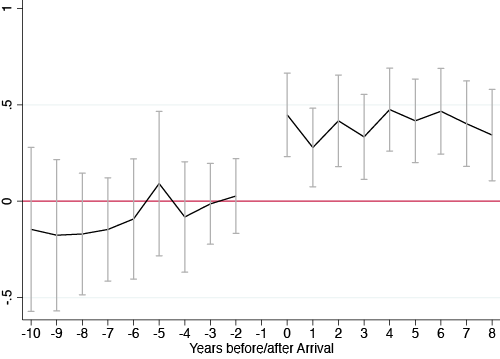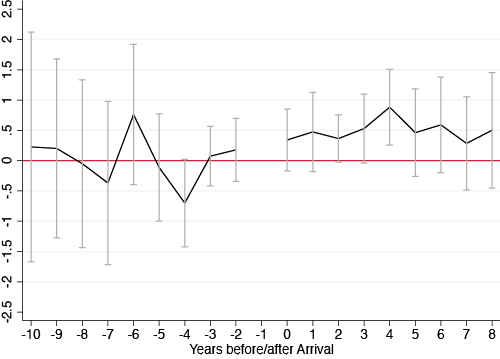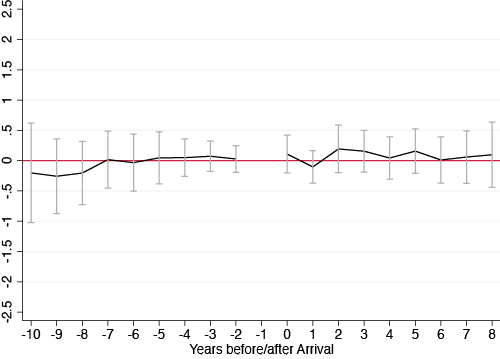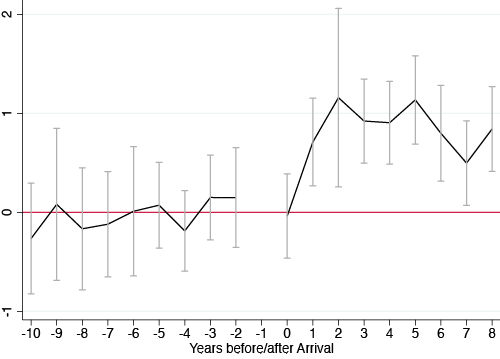CEOs and policymakers show increasing interest in the role of stars in the performance of local economies including cities, regions, companies, and universities. Many assert that, in addition to the direct impact of stars, their arrival will catalyse a larger positive growth dynamic. However, we have a limited understanding of how much and why stars matter.
Even in today’s world of easy communication, evidence shows that knowledge transfer is disproportionately local (Jaffe et al. 1993, Agrawal et al. 2006). This suggests the benefits of proximity to stars – individuals who produce a disproportionate fraction of new knowledge. In a recent NBER working paper (Agrawal et al. 2014), we use a rich longitudinal dataset on incumbent and subsequent recruit (‘joiner’) productivity in a contemporary field of science to examine the range of channels through which stars might matter.
We examine the effect of hiring a star on incumbent productivity, distinguishing between incumbents who are related and unrelated to the star in ‘idea space’. We also examine the effect of a star arrival on the quality of subsequent recruits, again distinguishing between related and unrelated joiners. Finally, we examine how the incumbent and joiner effects are mediated by the rank of the hiring institution. Taken together, these results allow us to look inside the black box of the how the location of stars affects knowledge production to better understand the forces driving the spatial organization of knowledge-intensive activities.
Related Literature
The existing literature has produced conflicting results on the importance of stars. For example, Waldinger (2012), using the dismissal of scientists in Nazi Germany as a natural experiment, does not find evidence of productivity effects on co-located peers. This is curious since the broader peer-effects literature documents significant productivity effects that are sensitive to the social proximity of interactions. Azoulay et al. (2010) and Oettl (2012) both report significant star-specific peer effects on co-authors utilising unexpected star deaths as a natural experiment. In terms of recruiting externalities, Waldinger (2013) uncovers evidence of long-lasting effects on the quality of star dismissals in Nazi Germany, while Roach and Sauermann (2010) report a strong preference of scientists to work with the best scientists possible.
Research Design and Data
Our research design involves examining the dynamic impacts of the first-star arrivals on departmental knowledge productivity, incumbent productivity, and the quality of joiners. We identify stars as individuals in the top decile of citation-weighted publication stocks, and base the estimates of star-arrival effects on a sample of 255 evolutionary biology departments that published almost 150,000 articles over the 29-year period from 1980 to 2008. We employ a differences-in-differences estimation approach, comparing the productivity/knowledge stocks of ‘treated’ to ‘control’ departments before and after the arrival of the star, where treatment refers to the arrival of the star.
Can we interpret these estimated ‘star effects’ as causal? The obvious concern is that observed star arrivals are correlated with developments already underway or contemporaneous with the arrival. To make the case for causality, we carefully examine pre-arrival trends, include controls for university/department-level resources, and use an instrument for star arrivals based on the ‘risk’ of non-co-located scientists moving to the department.
Results
We find evidence of a large overall star effect.
• On average, department-level output increases by 54% after the arrival of a star.
A significant fraction of the star effect is indirect. After removing the direct contribution of the star, department-level output still increases by 48%.
• In terms of department-level productivity, which we estimate by controlling for department size, we observe a 26% increase after excluding the star’s contribution.
This implies that much of the observed indirect output gains are due to increasing department quality, not just size.
• The effect does not seem to diminish even by the end of our post-arrival window, eight years after the arrival of the star.
The key results can be usefully summarized by spline graphs that show the effects of star arrivals both before and after the actual arrival. In particular, the pre-arrival effect allows us to check if the effects are visible before the actual arrival. Such pre-trends would suggest that star recruitment is part of a broader department-improvement strategy. The spline graphs also allow us to examine how the star effect evolves over time, which will be particularly influenced by the effect on subsequent recruitment. Figure 1 shows the productivity effects both including and excluding the star. No evidence of a pre-trend is visible, and the positive effect of the star arrival endures over the full post-arrival window.
Figure 1. Department Output Excluding Star1
We do not find evidence of a statistically significant effect of star arrival on incumbents overall. However, this hides quite different effects for related and unrelated incumbents. Figures 2a and 2b show the spline graphs for both related and unrelated incumbents, respectively. Incumbents working in ‘idea space’ related to the star do show positive productivity effects, which appears to be increasing with the time since arrival. We observe no effect for unrelated incumbents.
Figure 2a. Related Incumbent Output
Figure 2b. Unrelated Incumbent Output
Probably the most striking effect observed is for the quality of subsequent recruits (see Figure 3):
• Post-arrival joiner quality increases by 68%, with the effect being most pronounced for related joiners.
Moreover, the positive joiner-quality effects appear to reach their maximum between two and five years after star arrival.
Figure 3. Joiner quality
We also examine the extent to which the size of the star effect is correlated with department rank, finding that the star effects are significantly greater at lower-ranked institutions.
Overall, we estimate that 9% of the indirect star effect is due to the higher productivity of related incumbents, 0% is due to unrelated incumbents, 38% is due to the increased quality of related joiners, and 53% is due to the increased quality of unrelated joiners. The importance of unrelated joiners is high relative to related joiners, despite the significantly greater individual quality increase for related joiners, due to the larger average number of unrelated joiners.
Policy implications
What are the policy implications of our findings on why stars matter? With the important caveat that our findings relate to a specific knowledge-production setting, the result concerning the relative importance of recruitment effects is striking. This suggests that star recruitment will best catalyze growth where there are significant opportunities for future expansion, especially – but certainly not exclusively – where the opportunities are in areas closely related to the star’s idea space. In other words, institutions that are not in the position to make subsequent hires may not benefit nearly as much as otherwise. Moreover, the finding that star effects are largest at mid-ranked institutions points to the role that star recruitment can play in moving an institution up the productivity rankings.
On the other hand, the apparent power of recruitment spillovers suggests a danger of inefficient lock-in, with stars becoming locally concentrated even where their individual work is relatively unrelated. This could potentially limit the formation of more dispersed but productive specialized clusters.
An immediate research challenge is to explore the generalizability of these findings. Science may be unusual in the importance placed on institution reputation for career standing. We hope that our findings on the size of the observed indirect productivity impacts following star arrival will stimulate further research on the nature and size of star effects in other settings.
References:
Agrawal, A., J. McHale, and A. Oettl (2014), “Why Stars Matter”, NBER Working Paper No. 20012.
Agrawal, A., I. Cockburn, and J. McHale (2006), “Gone but not forgotten: Knowledge flows, labour mobility, and enduring social relationships”, Journal of Economics Geography 6 (5), 571–591.
Azoulay, P., J. Graff Zivin, and J. Wang (2010), “Superstar extinction”, Quarterly Journal of Economics 125 (2), 549–589.
Jaffe, A. B., M. Trajtenberg, and R. Henderson (1993, August), “Geographic localization of knowledge spillovers as evidenced by patent citations”, Quarterly Journal of Economics 108 (3), 577–598.
Oettl, A. (2012), “Reconceptualizing stars: Scientist helpfulness and peer performance”, Management Science 58 (6), 1122–1140.
Roach, M. and H. Sauermann (2010), “A taste for science? Phd scientists’ academic orientation and self-selection into research careers in industry”, Research Policy 39 (3), 422–434.
Waldinger, F. (2012), “Peer effects in science: Evidence from the dismissal of scientists in Nazi Germany”, The Review of Economic Studies 79 (2), 838–861.
Waldinger, F. (2013), “Bombs, brains, and science: The role of human and physical capital for the creation of scientific knowledge” University of Warwick mimeo.
1 This figure plots point estimates for leading and lagging indicators for the arrival of a department’s first star. The figure plots the point estimates of the following specification: E[Y_it] = exp(a_-10*Star_it-10 + a_-9*Star_it-9 + ... + a_-2*Star_it-2 + a_0*Star_it + ... + a8*Star_it+8 + B*logScientists_it + d_t + m_i). E[Y_it] is the output of department i in year t. Star_it-10 is set to 1 for years up to and including 10 years prior to the arrival of the star and 0 otherwise. Star_it+8 is set to 1 for all years eight years after the arrival of the star and 0 otherwise. logScientists controls for the number of scientists present in year t at department i. The omitted category is one year prior to the star’s arrival. The vertical bars correspond to 95% confidence intervals with department-clustered standard errors.









